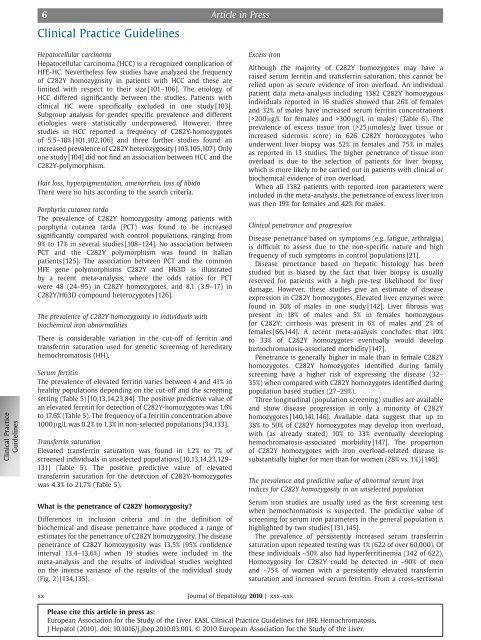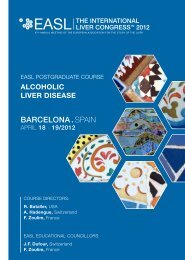EASL clinical practice guidelines for HFE Hemochromatosis
EASL clinical practice guidelines for HFE Hemochromatosis
EASL clinical practice guidelines for HFE Hemochromatosis
You also want an ePaper? Increase the reach of your titles
YUMPU automatically turns print PDFs into web optimized ePapers that Google loves.
6 Article in PressClinical Practice GuidelinesClinical PracticeGuidelinesHepatocellular carcinomaHepatocellular carcinoma (HCC) is a recognized complication of<strong>HFE</strong>-HC. Nevertheless few studies have analyzed the frequencyof C282Y homozygosity in patients with HCC and these arelimited with respect to their size [101–106]. The etiology ofHCC differed significantly between the studies. Patients with<strong>clinical</strong> HC were specifically excluded in one study [103].Subgroup analysis <strong>for</strong> gender specific prevalence and differentetiologies were statistically underpowered. However, threestudies in HCC reported a frequency of C282Y-homozygotesof 5.5–10% [101,102,106] and three further studies found anincreased prevalence of C282Y heterozygosity [103,105,107]. Onlyone study [104] did not find an association between HCC and theC282Y-polymorphism.Hair loss, hyperpigmentation, amenorrhea, loss of libidoThere were no hits according to the search criteria.Porphyria cutanea tardaThe prevalence of C282Y homozygosity among patients withporphyria cutanea tarda (PCT) was found to be increasedsignificantly compared with control populations, ranging from9% to 17% in several studies [108–124]. No association betweenPCT and the C282Y polymorphism was found in Italianpatients [125]. The association between PCT and the common<strong>HFE</strong> gene polymorphisms C282Y and H63D is illustratedby a recent meta-analysis, where the odds ratios <strong>for</strong> PCTwere 48 (24–95) in C282Y homozygotes, and 8.1 (3.9–17) inC282Y/H63D compound heterozygotes [126].The prevalence of C282Y homozygosity in individuals withbiochemical iron abnormalitiesThere is considerable variation in the cut-off of ferritin andtransferrin saturation used <strong>for</strong> genetic screening of hereditaryhemochromatosis (HH).Serum ferritinThe prevalence of elevated ferritin varies between 4 and 41% inhealthy populations depending on the cut-off and the screeningsetting (Table 5) [10,13,14,23,84]. The positive predictive value ofan elevated ferritin <strong>for</strong> detection of C282Y-homozygotes was 1.6%to 17.6% (Table 5). The frequency of a ferritin concentration above1000 mg/L was 0.2% to 1.3% in non-selected populations [34,133].Transferrin saturationElevated transferrin saturation was found in 1.2% to 7% ofscreened individuals in unselected populations [10,13,14,23,129–131] (Table 5). The positive predictive value of elevatedtransferrin saturation <strong>for</strong> the detection of C282Y-homozygoteswas 4.3% to 21.7% (Table 5).Excess ironAlthough the majority of C282Y homozygotes may have araised serum ferritin and transferrin saturation, this cannot berelied upon as secure evidence of iron overload. An individualpatient data meta-analysis including 1382 C282Y homozygousindividuals reported in 16 studies showed that 26% of femalesand 32% of males have increased serum ferritin concentrations(>200 mg/L <strong>for</strong> females and >300 mg/L in males) (Table 6). Theprevalence of excess tissue iron (>25 mmoles/g liver tissue orincreased siderosis score) in 626 C282Y homozygotes whounderwent liver biopsy was 52% in females and 75% in malesas reported in 13 studies. The higher penetrance of tissue ironoverload is due to the selection of patients <strong>for</strong> liver biopsy,which is more likely to be carried out in patients with <strong>clinical</strong> orbiochemical evidence of iron overload.When all 1382 patients with reported iron parameters wereincluded in the meta-analysis, the penetrance of excess liver ironwas then 19% <strong>for</strong> females and 42% <strong>for</strong> males.Clinical penetrance and progressionDisease penetrance based on symptoms (e.g. fatigue, arthralgia)is difficult to assess due to the non-specific nature and highfrequency of such symptoms in control populations [21].Disease penetrance based on hepatic histology has beenstudied but is biased by the fact that liver biopsy is usuallyreserved <strong>for</strong> patients with a high pre-test likelihood <strong>for</strong> liverdamage. However, these studies give an estimate of diseaseexpression in C282Y homozygotes. Elevated liver enzymes werefound in 30% of males in one study [142]. Liver fibrosis waspresent in 18% of males and 5% in females homozygous<strong>for</strong> C282Y; cirrhosis was present in 6% of males and 2% offemales [66,144]. A recent meta-analysis concludes that 10%to 33% of C282Y homozygotes eventually would develophemochromatosis-associated morbidity [147].Penetrance is generally higher in male than in female C282Yhomozygotes. C282Y homozygotes identified during familyscreening have a higher risk of expressing the disease (32–35%) when compared with C282Y homozygotes identified duringpopulation based studies (27–29%).Three longitudinal (population screening) studies are availableand show disease progression in only a minority of C282Yhomozygotes [140,141,146]. Available data suggest that up to38% to 50% of C282Y homozygotes may develop iron overload,with (as already stated) 10% to 33% eventually developinghemochromatosis-associated morbidity [147]. The proportionof C282Y homozygotes with iron overload-related disease issubstantially higher <strong>for</strong> men than <strong>for</strong> women (28% vs. 1%) [146].The prevalence and predictive value of abnormal serum ironindices <strong>for</strong> C282Y homozygosity in an unselected populationWhat is the penetrance of C282Y homozygosity?Differences in inclusion criteria and in the definition ofbiochemical and disease penetrance have produced a range ofestimates <strong>for</strong> the penetrance of C282Y homozygosity. The diseasepenetrance of C282Y homozygosity was 13.5% (95% confidenceinterval 13.4–13.6%) when 19 studies were included in themeta-analysis and the results of individual studies weightedon the inverse variance of the results of the individual study(Fig. 2) [134,135].Serum iron studies are usually used as the first screening testwhen hemochromatosis is suspected. The predictive value ofscreening <strong>for</strong> serum iron parameters in the general population ishighlighted by two studies [131,145].The prevalence of persistently increased serum transferrinsaturation upon repeated testing was 1% (622 of over 60,000). Ofthese individuals ~50% also had hyperferritinemia (342 of 622).Homozygosity <strong>for</strong> C282Y could be detected in ~90% of menand ~75% of women with a persistently elevated transferrinsaturation and increased serum ferritin. From a cross-sectionalxxJournal of Hepatology 2010 | xxx–xxxPlease cite this article in press as:European Association <strong>for</strong> the Study of the Liver. <strong>EASL</strong> Clinical Practice Guidelines <strong>for</strong> <strong>HFE</strong> <strong>Hemochromatosis</strong>.J Hepatol (2010). doi: 10.1016/j.jhep.2010.03.001. © 2010 European Association <strong>for</strong> the Study of the Liver.












